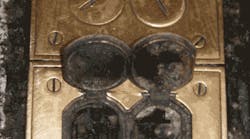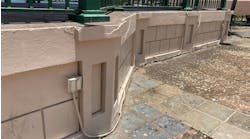How well do you know the Code? Think you can spot violations the original installer either ignored or couldn't identify? Here's your chance to moonlight as an electrical inspector and second-guess someone else's work from the safety of your living room or office. Joe, who has a knack for finding shoddy electrical work, did the dirty work and found this mess. Now it's your turn to identify the violation.
Find the Answer
This floor receptacle is located in front of a popular computer store in a major shopping mall. The corrosion and damage to this receptacle were most likely caused by the daily floor cleaning operation that has taken place over the years. I'm sure the other receptacles in the mall were likely in the same condition. The local electrical inspector was notified of this situation.
Although this particular branch circuit was not energized, it could have been if the conductor termination at the overcurrent device was still connected, as it was still in the ON position.
When these types of installations are repaired they are required to comply with Section 314.27(C) of the 2008 NEC, which states, "Boxes listed specifically for this application shall be used for receptacles located in the floor." An exception to this requirement reads as follows: "Where the authority having jurisdiction judges them free from likely exposure to physical damage, moisture, and dirt, boxes located in elevated floors of show windows and similar locations shall be permitted to be other than those listed for floor applications. Receptacles and covers shall be listed as an assembly for this type of location."
According to current UL standards, floor boxes designated for floor installation as covered in the NEC are provided with covers and gaskets to exclude surface water and sweeping compounds that might be present in floor cleaning operations. Those boxes, intended for installation in concrete floors, are frequently provided with leveling screws, threaded hubs, or both and are provided with a marking on the carton to identify boxes of this type such as "‘Floor Box"’ or "‘Floor Box, Concrete Tight"’ as appropriate.



